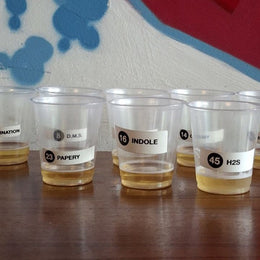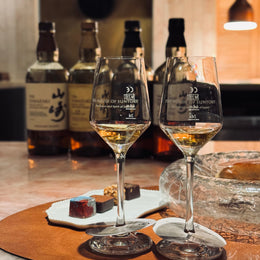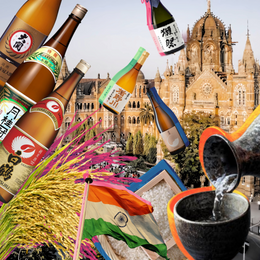It’s no secret or surprise that rice is pretty much the main character of sake. Sake grades are categorized based on the degree of polishing that the sake rice has undergone, and the varietal of rice and origin region has a significant impact on the flavour and quality of the sake. Sake is made using a type of rice known as Japonica rice (only cultivated in Japan, as the name implies). In Japan, there are approximately 270 varieties of Japonica rice grown locally. That’s almost one rice varietal for each working day of the year!
Sake rice (also known as Sakamai) are large rice grains with a white core of starch granules and have a lower protein and fat content than regular table rice. Sake rice is also more premium than your regular table rice, being of a larger grain size and 20% more expensive than table rice on average.

From left to right - Brown rice, 40% polished rice, 50% polished rice (ginjo-shu), 60% polished rice (daiginjo-shu) (Image Courtesy of web-japan.org)
Each region in Japan has its own designated varieties of sake rice – that’s why you may see many sake distilleries talk about how the taste of the region in the sake, and while many other factors such as the weather and the water play an important role in this, you can taste a major difference in sake made from different rice varietals!
The most well-known and premium varietals of rice we see in sakes are Yamadanishiki, Gohyakumangoku, Miyama Nishiki, as well as Omachi (which we’ll explore in greater detail here). Of course, there are many other varietals of sake rice, with new improvements and innovations being made through cross-producing techniques of different related rice varieties.
Yamada Nishiki Rice
Dubbed the “King of Sake Rice”, Yamada Nishiki rice is ideal for rice polishing with its large grain size, high proportion of its white starchy core (also known as shinpaku), and low protein content. Yamada Nishiki rice is also resilient to breaking from polishing, making it easy for sake brewers to control the polishing amount and polish it to higher degrees, making more premium grade sake with higher polishing ratios.

 A comparison of shinpaku between Yamada Nishiki sake rice grain and regular table rice grain (Source: Japan Sake and Shochu Makers Association)
A comparison of shinpaku between Yamada Nishiki sake rice grain and regular table rice grain (Source: Japan Sake and Shochu Makers Association)
Yamada Nishiki rice originated from the Hyogo region in the early 20th century during the Taisho period in Japan, and is mainly sourced from the Hyogo, Fukuoka and Toukushima regions.
This premium sake rice results in sakes that have a fruity, aromatic, and complex flavour profile – it’s not hard to see why sakes produced from Yamada Nishiki rice are so popular!
Gohyakumangoku Rice
Gohyakumangoku rice originates from the Niigata region in Japan, and its name was officially registered in 1957, which translates to mean “five million koku” – koku being a measurement of rice yield, and the rice being named as such to commemorate Niigata’s rice yield surpassing the five million koku (approximately nine million litres) mark that year. Gohyakumangoku rice is also cultivated in the Fukushima, Toyama, and Ishikawa regions of Japan.
The Gohyakumangoku rice grain has a large shinpaku which is well clustered in the centre of the rice grain, which allows for the milling process to effectively remove the outer protein and lipids layer of the rice grain, removing any undesirable flavours and qualities from the sake.
The sake that Gohyakumangoku rice produces tends to have flavour profiles that are light, clean dry, smooth, and very refined – a signature of the Niigata style of sake.
Miyama Nishiki Rice
Miyama Nishiki is a cultivated rice that originated in Nagano Prefecture in Japan, and its name translates to “beautiful mountain brocade”. The Miyama Nishiki rice grain thrives and grows in colder climates, and is also grown in colder regions of Japan such as Akita, Tamagata, and Iwate.
 The beautiful climate of Nagano, the origin of Miyama Nishiki sake rice. (Image Courtesy of SakeMaru.me)
The beautiful climate of Nagano, the origin of Miyama Nishiki sake rice. (Image Courtesy of SakeMaru.me)
Miyama Nishiki rice produces sake that has a clean, smooth, light, and refreshing texture, and is often used to produce Junmai Ginjo sakes.
Omachi Rice
Omachi rice originates from Okayama Prefecture in Japan, which accounts for 90% of all Omachi rice production. Omachi rice is also known to be the ancestor of the “King of Sake” rice, Yamada Nishiki, and is also known for being notoriously difficult to harvest due to the combination of the tall height of the rice stalk and large sized rice grains, which makes them susceptible to being destroyed by strong winds and insects. Omachi is also a pure sake rice strain, meaning it has not been cultivated through cross-breeding and mutations, while almost all other varieties of sake rice are a product of cross-breeding. As such, Omachi rice has a certain “wild” quality about it, which produces very distinctive flavours in sake, capturing the terroir of the region.
 We love a long boi - Omachi rice stalks can grow to as long as 120cm (Image Courtesy of Sakemaru.me)
We love a long boi - Omachi rice stalks can grow to as long as 120cm (Image Courtesy of Sakemaru.me)
Sakes produced from Omachi rice are known for their more defined and earth flavour profiles, with a well-rounded texture and complex umami. The complexity that Omachi rice produces also allows for more interesting flavour transformations when the sake is aged or matured.
Over the years, Omachi rice sake has gained quite a cult following among sake connoisseurs, with a enthusiastic fanbase that refer to themselves as “Omachists”.
Sake Rice & Terroir
There are many sake rice varietals that are grown and suited to different specific climates, and purposes across different regions in Japan. Outside of this list of the 4 major types of sake rice, there is of course a wider range of sake rice varietals, which open the doors to more distinctive flavour profiles and approaches to showcasing the terroir of their different regions. However, terroir in sake is not purely expressed through the type of sake rice varietal. Lots of other factors play a critical role in painting a larger picture of the region’s flavour profile, such as the water, koji, yeast and mastery of the sake brewer, which work together to give you an experience of what a Niigata-style sake would taste like, for instance.
Ultimately, the range of sake rice varietals and their characteristics that are distinctive and unique to each region is what allows those of us who enjoy sake to have an even deeper appreciation of the sake-making craft and the unique qualities of different regions in Japan. It is, as they say, that variety is the spice of life.
Till the next time, happy sipping!

@ChopstickPride







